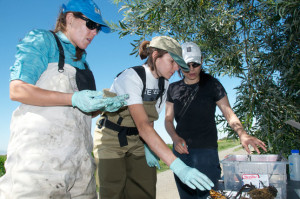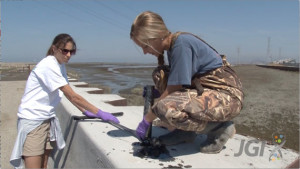Patterns in carbon sequestration and emissions are charted in the San Joaquin Delta.
The Science:
Researchers at the DOE Joint Genome Institute sequenced and analyzed the microbial communities in restored wetlands in the Sacramento-San Joaquin Delta and combined the data with greenhouse gas measurements from the area to track patterns in methane emissions.

After a day collecting samples from Twitchell Island, located in the Sacramento-San Joaquin Delta of California, USGS scientist and study co-author Lisamarie Windham-Myers (left), study senior author Susannah Tringe (center), and study first author Shaomei He (right) go over their preliminary findings. (David Gilbert, DOE JGI). A video about the project can be viewed here.
The Impact:
Though wetlands account for less than 10 percent of the planet’s land surface area, they trap as much as 30 percent of global soil carbon. In addition, natural wetlands can emit nearly 40 percent of global methane emissions. Determining if restored wetlands could serve as carbon sinks or act as carbon emitters is a key goal of the project.
Summary
In the late 19th and early 20th century, several freshwater tidal marshes in California’s Sacramento-San Joaquin Delta were drained and converted for agricultural purposes. A century later, the U.S. Geological Survey (USGS) and the California Department of Water Resources launched a pilot project focused on Twitchell Island to restore these wetlands for a number of reasons, including the mitigation of levee failure, land surface subsidence and erosion.
Wetlands cover less than 10 percent of the Earth’s land surface, but they can trap as much as 30 percent of global soil carbon, as well as emit nearly 40 percent of global methane emissions. Before agencies can consider long-term wetland restoration projects, they want to learn more about whether or not restored wetlands can serve as carbon sinks or act as carbon emitters.
In a study published May 19, 2015 in the journal mBio, a team led by Susannah Tringe, head of the Metagenome Program at the U.S. Department of Energy Joint Genome Institute (DOE JGI), a DOE Office of Science user facility managed by Lawrence Berkeley National Laboratory, reported on microbial community composition and carbon emissions patterns from data collected at different times, from Twitchell Island sites near the inlet and leading toward the interior of the wetland.
The team collected an abundance of data relating to microbial community composition and greenhouse gas emissions. DNA collected from the soil samples was sequenced and analyzed at the DOE JGI. One of the team’s findings was that the microbial communities present in the restored wetlands were more diverse than the composition of the microbial communities in an adjacent cornfield. Additionally, the river water became slightly more acidic as it moved from the river inlet toward the wetland interior, likely due to the decomposing plant mass found “inland.” A similar pattern was observed regarding the methane emissions, with lower emissions detected at the inlet compared to the interior sites.

DOE JGI Metagenome Program Head Susannah Tringe and postdoc Susie Theroux discuss the lessons to be learned from studying the microbial diversity of marshes that have been converted to other uses, and are now being restored, as well as the potential impacts on the global carbon cycle. Watch the video at http://bit.ly/JGI15CCMarshes.
“The differences in microbial community composition and functional profiles reveal complex interactions among functional guilds and among wetland plants, microorganisms and their environment,” the team reported. “Based on these findings, more specific studies can be carried out to evaluate the impact of wetland water chemistry and hydrology on CH4 emission and carbon sequestration before large-scale restoration projects are implemented.”
In 2011, Susannah Tringe, Metagenome Program Lead, received a DOE Office of Science Early Career Research Program grant to study microbial communities in restored wetlands. Watch a video of Tringe introducing the project and the work at Twitchell Island at http://bit.ly/JGIwetlandsvid. In recent years, Tringe has expanded her focus to included restored wetlands around the San Francisco Bay Area; watch the newest video at http://bit.ly/JGI15CCMarshes.
Contact
Susannah Tringe
DOE Joint Genome Institute
[email protected]
Funding
- U.S. Department of Energy Early Career Research Program
- U.S. Department of Energy Office of Science
- U.S. Geological Survey Climate and Land Use Change Program
Publication
- He S et al. Patterns in wetland microbial community composition and functional gene repertoire associated with methane emissions. mBio. 2015 May 19;6(3). pii: e00066-15. doi: 10.1128/mBio.00066-15.
Related Links
- Women @ Energy: Susannah Green Tringe
- Video: JGI’s Carbon Cycling Studies on Restored Remnant Marshes
- Video: Wetlands, Microbes, and the Carbon Cycle: Behind the Scenes @ Berkeley Lab
- JGI Release: JGI’s Susannah Tringe Receives Prestigious $2.5M DOE Early Career Research Award
- Feature: Tringe on Popular Science’s “Brilliant 10” List